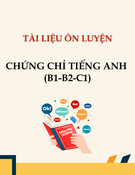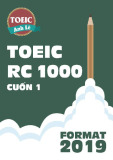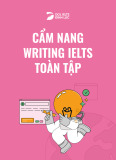
1
IELTS Academic Reading 9
You should spend about 20 minutes on Questions 30-41 which are based on the
Reading Passage below.
PAPER RECYCLING
A Paper is different from other waste produce because it comes from a sustainable
resource: trees. Unlike the minerals and oil used to make plastics and metals, trees are
replaceable. Paper is also biodegradable, so it does not pose as much threat to the
environment when it is discarded. While 45 out of every 100 tonnes of wood fibre used to
make paper in Australia comes from waste paper, the rest comes directly from virgin fibre
from forests and plantations. By world standards this is a good performance since the world-
wide average is 33 per cent waste paper. Governments have encouraged waste paper
collection and sorting schemes and at the same time, the paper industry has responded by
developing new recycling technologies that have paved the way for even greater utilization
of used fibre. As a result, industry’s use of recycled fibres is expected to increase at twice
the rate of virgin fibre over the coming years.
B Already, waste paper constitutes 70% of paper used for packaging and advances in the
technology required to remove ink from the paper have allowed a higher recycled content in
newsprint and writing paper. To achieve the benefits of recycling, the community must also
contribute. We need to accept a change in the quality of paper products; for example
stationery may be less white and of a rougher texture. There also needs to be support from
the community for waste paper collection programs. Not only do we need to make the paper
available to collectors but it also needs to be separated into different types and sorted from
contaminants such as staples, paperclips, string and other miscellaneous items.
C There are technical limitations to the amount of paper which can be recycled and some
paper products cannot be collected for re-use. These include paper in the form of books and
permanent records, photographic paper and paper which is badly contaminated. The four
most common sources of paper for recycling are factories and retail stores which gather
large amounts of packaging material in which goods are delivered, also offices which have
unwanted business documents and computer output, paper converters and printers and
lastly households which discard newspapers and packaging material. The paper
manufacturer pays a price for the paper and may also incur the collection cost.
D Once collected, the paper has to be sorted by hand by people trained to recognise various
types of paper. This is necessary because some types of paper can only be made from
particular kinds of recycled fibre. The sorted paper then has to be repulped or mixed with
water and broken down into its individual fibres. This mixture is called stock and may contain
a wide variety of contaminating materials, particularly if it is made from mixed waste paper
which has had little sorting. Various machineries are used to remove other materials from
the stock. After passing through the repulping process, the fibres from printed waste paper
are grey in colour because the printing ink has soaked into the individual fibres. This
recycled material can only be used in products where the grey colour does not matter, such
as cardboard boxes but if the grey colour is not acceptable, the fibres must be de-inked. This
involves adding chemicals such as caustic soda or other alkalis, soaps and detergents,
water-hardening agents such as cal-cium chloride, frothing agents and bleaching agents.
ZIM ACADEMY | Room 2501, Ocean Group Building, 19 Nguyen Trai, Thanh Xuan Dist, Hanoi

1
Before the recycled fibres can be made into paper they must be refined or treated in such a
way that they bond together.
E Most paper products must contain some virgin fibre as well as recycled fibres and unlike
glass, paper cannot be recycled indefinitely. Most paper is down-cycled which means that a
prod-uct made from recycled paper is of an inferior quality to the original paper. Recycling
paper is beneficial in that it saves some of the energy, labour and capital that go into
producing virgin pulp. However, recycling requires the use of fossil fuel, a non-renewable
energy source, to collect the waste paper from the community and to process it to produce
new paper. And the recycling process still creates emissions which require treatment before
they can be disposed of safely. Nevertheless, paper recycling is an important economical
and environmental practice but one which must be carried out in a rational and viable
manner for it to be useful to both industry and the community.
Questions 30-36
Complete the summary below of the first two paragraphs of the Reading Passage.
Choose ONE OR TWO WORDS from the Reading Passage for each answer.
Write your answers in boxes 30-36 on your answer sheet.
SUMMARY
Example ....
From the point of view of recycling, paper has two advantages over minerals
and ...........oil.......... in that firstly it comes from a resource which is ........ (30) ........ and
secondly it is less threatening to our environment when we throw it away because it is .......
(31) ...... Although Australia’s record in the re-use of waste paper is good, it is still necessary
to use a combination of recycled fibre and ........ (32) ........ to make new paper. The paper
industry has contributed positively and people have also been encouraged by .........
(33) ......... to collect their waste on a regular basis. One major difficulty is the removal of ink
from used paper but ......... (34) ......... are being made in this area. However, we need to
learn to accept paper which is generally of a lower ......... (35) ......... than before and to sort
our waste paper by removing ......... (36) ........ before discarding it for collection.
Look at paragraphs C, D, and E and, using the information in the passage, complete the
flow chart below. Write your answers in boxes 37-41 on your answer sheet. Use ONE OR
TWO WORDS for each answer.
ZIM ACADEMY | Room 2501, Ocean Group Building, 19 Nguyen Trai, Thanh Xuan Dist, Hanoi

1
ZIM ACADEMY | Room 2501, Ocean Group Building, 19 Nguyen Trai, Thanh Xuan Dist, Hanoi

1
Answer:
30. sustamable 31. biodegradable 32. virgin fibre/ pulp 33. governments/ the
government 34. advances 35. quality 36. contaminants 37. offices 38.
sorted 39. (re)pulped 40. de-ink/ remove ink/ make white 41. refined
ZIM ACADEMY | Room 2501, Ocean Group Building, 19 Nguyen Trai, Thanh Xuan Dist, Hanoi



![Tài liệu luyện thi TOEIC cấp tốc trong 10 ngày [chuẩn nhất]](https://cdn.tailieu.vn/images/document/thumbnail/2025/20251029/kimphuong1001/135x160/99661761725822.jpg)
![Tài liệu Phá đảo TOEIC 900+ từ mất gốc trong 30 ngày [Mới nhất]](https://cdn.tailieu.vn/images/document/thumbnail/2025/20251029/kimphuong1001/135x160/2101761720956.jpg)











